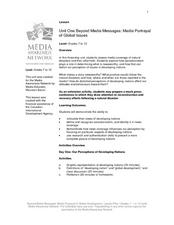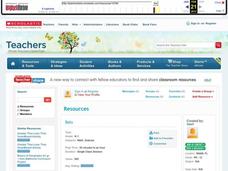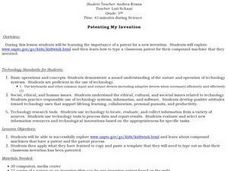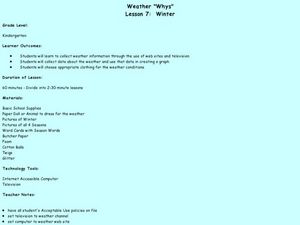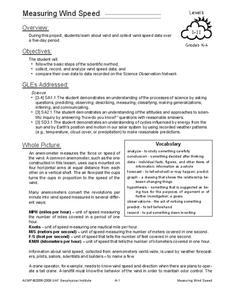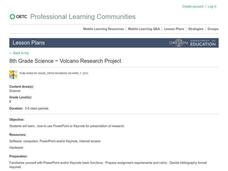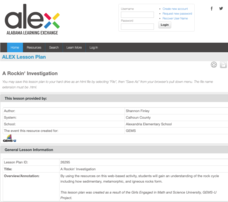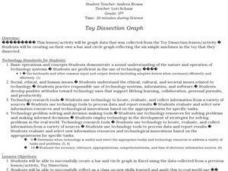Curated OER
Beyond Media Messages: Media Portrayal of Global Issues
Take a close look at news reporting techniques and global issues. Begin by creating a graphic representation of developing nations and defining the term. After class discussion, the second day's activities pick up by deconstructing news...
Growing Minds
Growing Minds: Cabbage Exploration
It's all about cabbage in this scientific observation resource! After reading a related story, learners explore three varieties of cabbage. They observe the leaves using a leaf diagram, predicting what the middle might look like. They...
Curated OER
Taking Action
Young scholars use the net they make to dip macroinvertebrates at or below the surface. The flat side of the net allows pressure on the substrate so that organisms do not escape under the net. Two students hold onto the handles and...
Curated OER
Animal Characteristics
Students investigate the characteristics of animals by creating a chart. In this animal life lesson, students create a KWL chart listing all the different animals a class can name. Students take a field trip to a science facility to get...
Curated OER
Layers of the Rainforest
What a great way to discuss the rainforest! Learners discuss the importance of adaptation in the environment and how it is linked to survival. They use critical thinking and inference skills to place animals and insects in the different...
Curated OER
Photo Synthesis and Transpiration
Young scholars germinate pea seeds and plant the seeds. They experiment with different amounts of light and darkness on the plant growth.
Curated OER
Bats
Students investigate bats. In this animal science lesson, students use several websites and suggested bat books to write an informative paragraph. Students should be able to write with 90% accuracy.
Curated OER
Rotocopters
Students construct their own rotocopters to study flight. In this flight lesson students work in groups and complete timed trials of their rotocopters.
Curated OER
Patenting My Invention
Fifth graders learn the importance of a patent for a new invention. They use the internet to practice typing a classroom patent for a compound machine that their class invented. While on the website, 5th graders choose a month and...
Curated OER
Love Them or Leave Them?
Students describe their pet and their feelings towards it and record their descriptive phrases on the board. They arrange comments on a spectrum from negative to positive. They read the article The Ambivalent Bond With a Ball of Fur and...
Curated OER
Recycling Who cares?
Students participate in activities to understand the feelings of the community about recycling. In this recycling lesson, students look at opposing views on recycling.
Curated OER
Environment: Sounds of the Natural World
Second graders describe and imitate sounds from the natural environment including rain and snow. After listing materials that could be used to make rainsticks, they create their own instruments from cardboard tubes,beans, and sand. To...
Curated OER
Weather Whys
Second graders experiment with a thermometer and water samples of varying temperatures. They examine the effect different colors and different fabrics have on retaining heat. They examine snow samples for water and dirt content. They...
Curated OER
Measuring Wind Speed
Students study wind speed and collect wind speed data. In this wind speed lesson, students visit a website to learn about the local wind speed forecast for their week. Students discuss wind and wind speed. Students collect wind speed...
Curated OER
Volcano Research Project
Eighth graders research about different types of volcanoes. In this earth science lesson, 8th graders create PowerPoint presentation on the information gathered. They share findings with the class.
Curated OER
I Spy Clouds in the Sky
Students search their room to learn cloud names and types. In this weather lesson, students scavenge the changing cloud scenery to memorize clouds types and facts. To add fun to the memorization the class plays I spy.
Curated OER
Highways and Stop Signs
Fourth graders investigate conductors and insulators and distinguish between the two. They utilize the digital camera and other forms of technology to create a study guide on conductors to help students develop sound knowledge.
Alabama Learning Exchange
A Rockin' Investigation
Young scientists identify the rock cycle. In this earth science activity, students participate in web-based research to understand how sedimentary, metamorphic, and igneous rocks form. As a follow-up, they collect various rocks and...
Curated OER
Simple Machines
Fifth graders create a Power Point presentation to relate to their study of simple machines. They create a title page, a page introducing six simple machines, slides explaining real world use to each simple machine and import pictures...
Curated OER
Breaking News English: Organ Donors
In this organ donors worksheet, students read the article, answer true and false questions, complete synonym matching, complete phrase matching, complete a gap fill, answer short answer questions, answer discussion questions, write, and...
Curated OER
Who is Rube Goldberg?
Fifth graders practice technology skills while searching online for information about inventor, Rube Goldberg. They discuss Rube Goldberg's use of simple machines, and write journal entries about their findings.
Curated OER
Rainforest/Informational Web Sites that are Credible
Fifth graders evaluate whether various rainforest websites are credible and can be used for research purposes. They listen to the story "The Great Kapok Tree," discuss what makes a website credible, and examine and evaluate various...
Curated OER
Exploring the Internet Properly
Students explore subscription databases, directories, and search engines to find information about a native Michigan animal. They research using the Internet and develop an understanding and appreciation for the resources available.
Curated OER
Toy Dissection Graph
Students explore simple machines and how they are made. They examine the parts of the simple machine and collect information about its parts. Using Excel, students create circle and bar graphs from the collected data.
